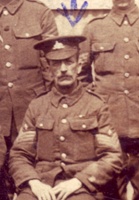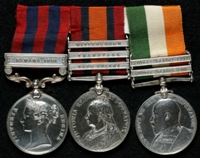
Photograph of Charles in Tameside Local Studies and Archives Centre. Reference: MR4/17/368

(L to R) India General Service Medal (1854) with clasp 'Samana 1891'; Queen's South Africa Medal with clasps 'Cape Colony', 'Transvaal', 'Wittebergen'; King's South Africa Medal with clasps 'South Africa 1901', 'South Africa 1902'
Charles was born on the 22nd February 1869 at 152 Long Millgate, Manchester. His father was called William and his mother was Mary Eliza. He had an older brother named George and 3 younger siblings called Alexander, William Herbert and Bertha. The family were members of the Church of England.
William had died by 1881 so we don't know what he did for a living. In that year the family lived at 43 Ashley Lane in Moston, Manchester.
Charles served in the 3rd Battalion of the Manchester Regiment at some point before mid 1887. We don't know how long he spent in this Militia unit, but he must have enjoyed Army life because on the 27th August he enlisted in the Regular Manchester Regiment.
At the time Charles was working as a labourer. He was 5 feet 4 1/4 inches tall and weighed 119 pounds. He had a 'sallow' complexion, grey eyes and dark brown hair. He was accepted into the Army and given the service number 1999.
We don't know much about Charles' service. After training at the Regimental Depot in Ashton-under-Lyne he was assigned to the 1st Battalion of the Manchester Regiment on the 3rd October 1887. The battalion was in Aldershot, Hampshire at the time.
Charles served with them until the 19th September 1889, when he was sent to join the 2nd Battalion in Agra near Delhi, India. They moved to Sialkot in what is now Pakistan during April 1890.
The next year Charles went to war. The 2nd Battalion of the Manchester Regiment was one of the units ordered to put down a rebellion in the Miranzai Valley on the North West Frontier with Afghanistan. Charles was one of the 300 Manchester Regiment soldiers who took part in this campaign, called the Miranzai Expedition. It lasted from the 3rd to the 25th May 1891. Samana is the name of the mountain range that rises out of the Miranzai Valley. The British fought hard to capture it.
Charles rejoined the rest of the 2nd Battalion at Sialkot. He obtained the 3rd Class Certificate of Education on the 21st January 1892. Later that year Charles moved to Dinapore (now Danapur) in eastern India. This was to be Charles' home until he left India on the 16th March 1895 to be transferred to the Army Reserve.
Charles had originally enlisted for 7 years in the Regular Army followed by 5 as a Reservist, but because he had served more than 7 years as a Regular his time in the Reserve was shortened to match. He was now free to find a home and a job, but he could be called back to the Army in an emergency. His time in the Reserve ended on the 28th August 1899.
Between July and September 1896 Charles married Susan Dunn in Manchester. Their daughter Susan was born in 1898, with Isabella following in 1900. By 1901 they were living at 4 Bratt Street in Collyhurst, Manchester.
The Boer War had broken out in South Africa in October 1899. It did not start well for the British and by the end of the year the Army was sending as many soldiers as it could to the country. On the 8th January 1900 Charles rejoined the Army Reserve, which tells us that he wanted to take part in the war. After 2 months he got his wish, sailing to South Africa on the 15th March 1900 with C Company of the 2nd Battalion of the Manchester Regiment.
Having more soldiers available meant that the British Army could try to force the Boers to face it in battle. By the end of 1900 they had captured most Boer towns, but they did not surrender and began to fight as guerrillas in small units, so Charles stayed in South Africa. He spent the rest of the war manning blockhouses and taking part in patrols of the countryside aimed at restricting the movements of the Boer forces. This was eventually successful.
Charles left South Africa on the 24th May 1902, a week before the war ended. We believe he left because he had developed an illness, although we don't know what it was or for how long it affected him. He was demobilised on the 1st March 1903 and returned to his civilian job as a postman. At some point before then he had been promoted to Corporal.
On the 7th January 1904 Charles' period of enlistment in the Army Reserve ended. We don't know where he and Susan lived between then and 1911, but they had 5 more children: Olive in 1903, Lola in 1904, Lena in 1906 and Charles junior in 1909. We don't know the name of their other child; they had died by 1911.
In that year the family lived at 227 Collyhurst Road and Charles worked as a porter in a cotton warehouse. He must have kept an interest in the military though, as on the 22nd August 1912 he joined the National Reserve. This was a voluntary register of men who had served in the military. There was no training involved, it was a way for the Government to keep in contact with people whose skills and experience might be of use in an emergency.
An emergency arose in August 1914 when the First World War broke out. The National Reserve would be called to duty in October, but Charles did not wait. He rejoined the Manchester Regiment on the 18th September and was given the service number 3099. His experience will have marked him out from most of the other new recruits, and he was soon promoted to Lance Sergeant.
At first Charles was a member of 3 Company in the 12th Battalion of the Manchester Regiment. This unit was sent overseas in July 1915, but Charles did not go with them. We don't know much about his movements during the war, but we believe he spent time as an instructor. He never served overseas, so he did not qualify for any First World War campaign medals.
By October 1916 Charles was a member of the 2nd (Home Service) Garrison Battalion of the Lincolnshire Regiment. His service number was 26469 and he was a Sergeant. Sadly we know this because this was his position at the time his daughter Lena died on the 14th. She was 10 years old and died of pneumonia at 266 Collyhurst Road.
Charles later served in the 23rd (Works) Battalion of the King's (Liverpool Regiment). This unit became the 1st Labour Battalion of the Labour Corps on the 28th April 1917. Charles' Labour Corps service number was 132046. He later served with the Western Command Labour Centre. We don't know anything about his job in these units.
By 1918 Charles was increasingly unfit. A note, presumably written by a doctor and intended for a more senior colleague tells us that he was 'really unfit to carry on. His hands puffy. Sweats at the least exertion and is in my opinion a case of myocardial degeneration. He had difficulty walking to and from Staff Quarters and really I do not consider him safe about the place. I have told him to report to you'.
We don't know when this was written, but it may be connected to Charles being sent to the King's Lancashire Military Convalescent Hospital on the 4th August 1918. Less than 2 months later on the 26th September he was discharged from the Army as 'no longer physically fit for war service'.
At that time he registered to vote in the 1918 General Election, to be held that December. He gave his address as 17 Church View in Moston, Manchester. We don't know when his family moved there.
The rest of Charles' life is a mystery. His medals were donated to the Museum of the Manchester Regiment in December 2005.




